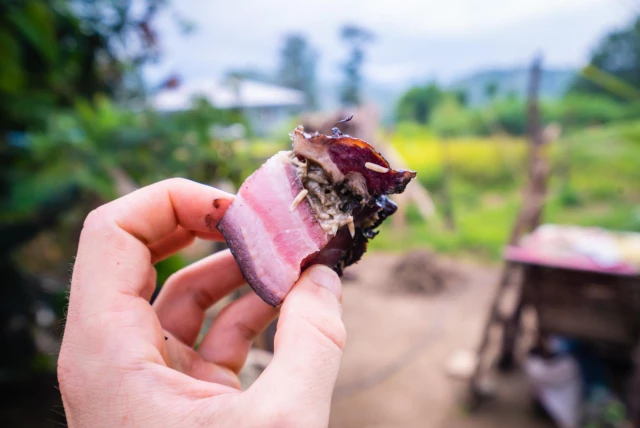
Etag is a traditional food from the Cordillera region of the Philippines that is made from pork that has been preserved with salt. It is a salty, smoky, and slightly chewy meat that is often used to flavor other dishes, such as pinikpikan.
The making of etag is a simple process that involves salting the pork and then either sun-drying or smoking it. The salt helps to preserve the meat and give it a salty, smoky flavor. The sun-drying or smoking process further preserves the meat and gives it a more intense flavor.
Traditionally, etag was made by hanging the salted pork in the sun for several days. However, today, etag is more commonly salted and then smoked. Smoking etag is still a common practice in the Cordillera region, but it is not as common as it used to be.
Etag is often sold in markets and stalls in the Cordillera region. It is also sometimes made at home. If you are lucky enough to find etag, be sure to try it! It is a delicious and unique delicacy that is a part of the Cordilleran culture.
Here are some tips for enjoying etag:
- Add it to a salad or stir-fry. Etag's salty, smoky flavor can add a delicious depth of flavor to any dish. Try adding it to a salad with greens, tomatoes, and cucumbers, or to a stir-fry with vegetables and your favorite protein.
- Use it to flavor a soup or stew. Etag can also be used to flavor soups and stews. Try adding it to a chicken noodle soup, a lentil soup, or a beef stew.
- Grill it and serve it with your favorite dipping sauce. Grilling etag is a great way to bring out its smoky flavor. Serve it with your favorite dipping sauce, such as barbecue sauce, ranch dressing, or a soy-based sauce.
Tips for Cooking Etag Safely
Etag is safe to eat as long as it has been properly cooked. To ensure that etag is cooked thoroughly, cook it until it reaches an internal temperature of 160 degrees Fahrenheit. You can use a meat thermometer to check the internal temperature.
It is also important to store etag properly. Etag should be stored in a cool, dry place. If you are storing etag for an extended period of time, you can freeze it.
I hope this helps!
Questions?
If you have any questions about etag, please feel free to ask me. I'm always happy to help!




















